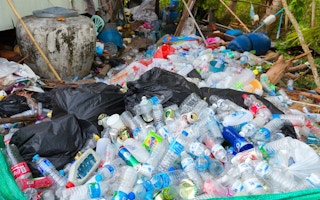Packaging waste is a problem that cannot be solved just by the packaging industry on its own.
To continue reading, subscribe to Eco‑Business.
There's something for everyone. We offer a range of subscription plans.
- Access our stories and receive our Insights Weekly newsletter with the free EB Member plan.
- Unlock unlimited access to our content and archive with EB Circle.
- Publish your content with EB Premium.
Instead, companies should adopt a systems approach to find solutions, said panellists at a recent workshop in Singapore on sustainable packaging.
Such an approach would mean that companies work with a wider group of stakeholders such as government, NGOs, and academia among others, to come up with solutions which benefit all the parties involved.
Erin Simon, the deputy director of private sector engagement at the World Wildlife Fund (WWF), opened the sustainable packaging workshop with her engaging talk on how to drive transformational change through the use of greener packaging.
She emphasised the need to look at the product life cycle through systems thinking. Given how multiple stakeholders are interdependent on each other in the global network of products and services, this approach provides a way for collaboration and innovation across a product’s life-cycle.
The Technical Workshop on Sustainable Packaging on May 24 was hosted by the WWF at the Copthorne King’s Hotel in Singapore. It was supported by the Singapore Packaging Agreement (SPA), an initiative by the National Environment Agency (NEA).
The SPA is a voluntary initiative between the government, industry and NGOs to reduce packaging waste. The SPA website said packaging waste makes up about one-third of Singapore’s total domestic waste by weight.
WWF’s Simon further spoke about the challenges and opportunities related to three key topics in packaging – bioplastics, forestry products and marine waste. She provided information on alliances and tools that are useful for the bioplastic industry and its stakeholders to tackle the packaging waste challenge of “reduce, reuse and recycle”.
The Bioplastics Feedstock Alliance is a guide to selecting feedstocks for bio-based plastics for sustainable flow of materials. WWF’s tools such as check your paper (CYP) and environmental paper company index promote transparency and provide information on footprints, evaluation and assessment of pulp and paper products. It partners with Ocean Conservancy (OC) in tackling marine waste.
A 2015 report by OC, states that “over half of the material leaked into the ocean comes from five rapidly-developing countries where production and consumption of plastics is outpacing local waste management capacity – China, Indonesia, Philippines, Vietnam, and Thailand , in order of magnitude”.
“
Industry needs to step up their packaging initiatives through systems approach and innovation.
Erin Simon, deputy director, private sector engagement, World Wildlife Fund
Industry perspective
Thinking in systems resonated through the rest of the industrial presentations.
Representatives from Nestlé and Sealed Air Corporation shared examples of sustainable initiatives they have introduced to improve packaging waste management.
Shi KeanTech, a packaging specialist from Nestlé’s R&D Centre, introduced the Packaging Environmental Sustainability Roadmap that looks at development and use of renewable and recycled materials and initiatives to recover used packaging and address littering.
Nestlé works with partners to “ensure that suitable infrastructure and awareness-raising activities are in place” and educate consumers on recovering used packaging. Shi highlighted that using recycled material for packaging is resource intensive. As such, recycled content is used only where it’s most appropriate.
Stefan Phang, Sealed Air Corporation’s regional director, spoke about innovation in recycling packaging, sharing two innovations which leveraged on partnerships between the private and public sectors.
One involved the use of glass and plastic bottles filled with a brick-like mixture to build a school in Laguna Province in the Philippines. The other involved using numerous cling films to make desks for schools in Indian villages.
He stressed on innovation being crucial in the reuse and repurpose of packaging waste. Focusing on building recycling plants, which require expensive infrastructure among other resources, is not the only solution for dealing with the waste, Phang added.
The take-away message for those who attended the workshop, though, was the WWF’s Simon’s reminder for the industry not to “act in silos” for materials management. Instead, companies should “step up your packaging initiatives through systems approach”, she said.










